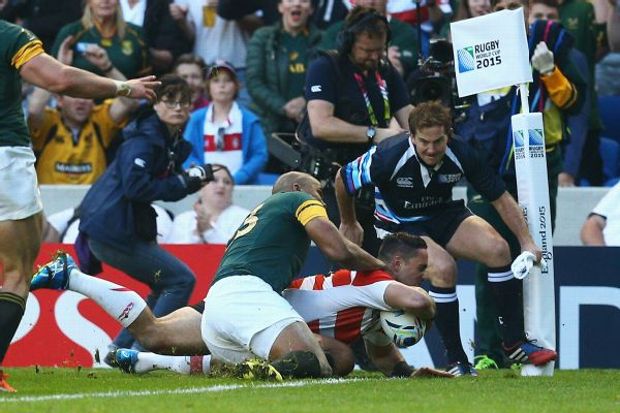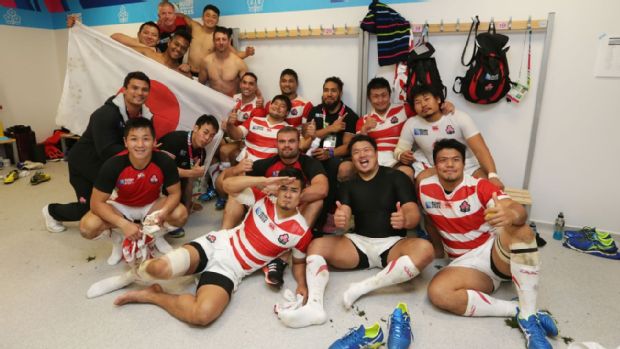|
Rugby World Cup
World Rugby still has plenty of work to ensure Japan triumph not glorious one-off
Huw Richards
September 22, 2015
Scotland v Japan Preview
Oh to have been in Brighton ... but the media centre at Twickenham wasn't a bad alternative as journalists of all nations erupted at Japan's winning score against South Africa. It was the perfect riposte to a frequent, and often justified criticism of the Rugby Union World Cup, that it is too predictable and fails to generate the shocks seen in other sports. That it was the greatest surprise in eight tournaments was not in doubt. You have to go to last year's women's tournament, and Ireland's defeat of New Zealand's Black Ferns, for anything comparable.  Karne Hesketh scores the match-winning try for Japan against South Africa© Charlie Crowhurst/Getty Images Previous men's World Cup shocks were different. They usually involved a south sea island picking off the lower-hanging fruit (all too often Wales) from World Rugby's Tier 1. This was an unquestioned giant, South Africa, overthrown by the team which might have been thought least likely of all to be able to withstand its ferocious physicality. This was the world turned upside down. Is this a glorious one-off, or the moment when Tier 2 closed that once-yawning gap to the established powers? Joyous and uplifting though the moment was, it is a little too soon to tell. The opening weekend four years ago in New Zealand offered nothing to match the Japanese triumph, but arguably saw better Tier 2 performances overall. Romania led Scotland until the 71st minute, while Japan trailed only 25-21 to France with 15 minutes to go. The USA held Ireland to 22-10. Yet that tournament largely upheld the status quo, Tonga's victory over France apart. The final eight were exactly the teams expected.
 Japan celebration© Steve Bardens - World Rugby/World Rugby via Getty Images At the same time that tournament certainly represented progress compared to the 2003 World Cup in Australia, which saw 18 teams topping 50 points, Namibia and Uruguay both conceding more than 100 and the 'Foundation Eight' filling the quarter-final places. It was those results which prompted the International Rugby Board (now World Rugby) to introduce targeted development funding for Tier 2 nations from 2005. And that bore unexpectedly rapid fruit at the 2007 tournament where Fiji beat Wales to reach the quarter-final, where they scared eventual winners South Africa, while Georgia should have beaten Ireland and Tonga gave both eventual finalists a hard time at the pool stage. The 50-pointers dropped to 12. That evident early progress underpinned the slight sense of disappointment attached to Tier 2 performances in 2011.
Against Japan's heroics last weekend we must weigh the concession of 50 points by both Uruguay and Canada. But Canada were playing the European champions of the past two seasons and the 54 conceded by Uruguay in Cardiff compares to the 111 they let in on their last finals outing, against England in Perth in 2003. We'll know more about other Tier 2 teams once they play Tier 1 opponents. But there was enough in Georgia's victory over Tonga to suggest that Argentina should not take them lightly. Much will depend on how other teams react to Japan's triumph. Will it inspire other Tier 2 teams to believe in their own chances or eliminate any risk of complacency from Tier 1 -- or perhaps both? Tier 1 has no reason for complacency. Where they not so long ago faced bank workers, students and farmers, they are now likely to be confronted by teams who have a core of hardened professionals, including stars of the Super 12 and the European Champions Cup. And a personal theory is that the World Rugby-funded pre-tournament camps are a big plus for Tier 2 teams, given an extended shot at team-bonding and -- just as important -- work on the combined moves and techniques so important in modern rugby. For them it is a life-enhancing novelty, while their Tier 1 counterparts must inevitably to some extent see yet another spell at Marcoussis or Pennyhill Park as an extended variation on a highly familiar theme. So kudos to World Rugby, but could they be doing more ? The £34 million put into development funding over the last four years sounds impressive, but in averaging £2.8m for each of the 12 Tier 2 nations it is dwarfed by the £7.5m paid to Tier 1 unions over the same World Cup cycle. Certainly it is good news that the number of Tier 1 v 2 fixtures over the most recent four-year cycle rose from 25 to 35, but that's still well under one match per country per year on either side of the divide. The memory goes back to George Simpkins, coach of the 1987 Fijians, saying "come and play us" and an eloquent plea along similar lines from Zaza Kasachvili of Georgia -- in the long-term perhaps the most promising Tier 2 nation -- after a World Cup qualifier at Lansdowne Road. Both countries can say they are still waiting. Big nations will plead pressure on players and balance sheets. But would it really hurt Wales so much to forego the annual agony at home to Australia for something different? And wouldn't any country learn about the character of young players from their reaction to the challenges of playing in Georgia or Romania? The delight on all sides at Japan's triumph was genuine. And real progress has been made. But if we want days like that to be more than fantastic one-offs, the game must follow through on its delight by willing the means to that end. © ESPN Sports Media Ltd.
|
Live Sports
Communication error please reload the page.
-
Football
-
Cricket
-
Rugby
-
- Days
- Hrs
- Mins
- Secs
F1 - Abu Dhabi GP
Abu Dhabi Grand Prix December 11-131. Max Verstappen ()
2. Valtteri Bottas (Mercedes)
3. Lewis Hamilton (Mercedes)
4. Alexander Albon ()
5. Lando Norris ()
6. Carlos Sainz Jr ()
-
ESPNOtherLive >>
Darts - Premier League
Golf - Houston Open
Snooker - China Open
Tennis - Miami Open


